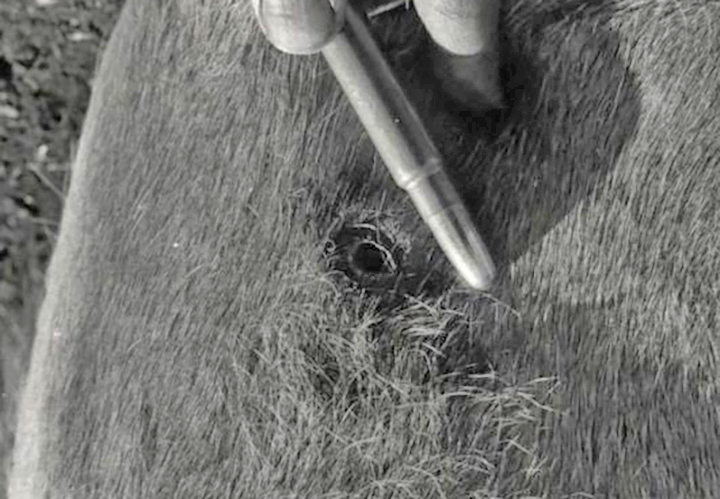Kentucky DPA approached me for a post-trial issue. They needed a terminal ballistics expert and gunfight dynamics expert, and perhaps other skills. The defendant, Mr. Ricardo Vettraino, a man of 1st generation Italian descent, from Detroit, Michigan; had been in Bowling Green, KY, seeking work as an electrician. He was convicted and sentenced to life WPOP, for the alleged execution style murder of the trophy wife of a very prominent local building contractor/developer (and a very heavy contributor to police oriented benevolent funds and charities).
The record showed that the Prosecution’s case was mostly emotion and puffery; none of which was challenged by the original defense attorney. It appeared that, when change of venue was denied, the defense attorney felt defeated and simply stumbled through the process. Even worse, the original defense attorney did not secure the services of any sort of firearms expert. The knucklehead thought he knew something about guns.
A hearing for a new trial had already been held before the trial judge, and I was summoned for a second hearing. My prehearing work with the post-conviction appeals attorney at the DPA, Mr. Brian T. Ruff, gave him the “ammunition” to zero in on expanded and additional discovery.
I studied the drawings, evidence locations, bullet holes and all the other stuff in the incident scene drawings and evidence inventories. As an expert in both gunfight dynamics and terminal ballistics, I told Brian that the only way this incident happened, was that two shooters were at the scene. Vettraino’s weapon was a handgun in 9mm Luger. As a firearms and ammunition design and manufacture expert; and based on my knowledge of the Sporting Arms and Ammunition Manufacturer’s Institute (SAAMI) standards, and the Commissione Internationale Permanente (CIP) standards, I told Brian that the other gun was a revolver in either .357 Magnum or .38 Special caliber.
The above standards set exactly the same rifling characteristics for those three calibers. That means that the bore diameter, groove diameter, number of grooves, width of grooves, and twist are the same. As an expert in ammunition manufacture, I knew that some ammunition factories used exactly the same bullets in the three different calibers of ammunition. Therefore the bullets would not be distinguishable upon recovery. Because only one manufacture of 9mm expended cartridge case had been recovered, that meant that the second handgun was a revolver, since the expended cartridge cases remain in a revolver until it is reloaded.
I briefed Bryan thoroughly on these issues and he strode into a deposition “loaded for bear”. Lo and behold, as Bryan zeroed in on the state trooper first to arrive at the scene, the trooper admitted that there had been both a shotgun and a second handgun (a revolver in .38 Special caliber) at the shooting incident scene. Both firearms were owned by the developer. But his supervisor, who was the next to arrive on the scene, told him that those two guns were not important and to hide them. The trooper complied with these orders.
Brian and I had worked before and Brian also knew my reputation from previous DPA cases. Brian was not a table pounder; he was very sharp and very methodical. He will run opposing counsel through with a verbal rapier before counsel knows what happened.
At the second hearing, the Prosecutor bitterly attacked me in every manner possible, even physically throwing a copy of my DD-214 Form at my face. But he also showed his incredible ignorance of SAAMI and many other firearms issues. With Brian’s adroit questioning, I was able to get the key defense points into the record.
First, more than one gun had been fired during the incident, thereby lending credence to the defendant’s claim that a gun had been pointed at him and he panicked, wildly returning fire. Second, there had not been a coup de grace shot fired as the deceased lay on the floor. In fact, the autopsy showed that the trophy wife could have been, and most likely was, shot from two different directions, at the same time. The Judge (who had helped “railroad” Vettraino before) began to soften as the hearing went on. The hearing ended with decision pending.
The case went back and forth over some 12 months, complicated by politics (in Bowling Green, both the judges and the prosecutors were elected) and other issues. Brian kept at it, flooding the Judge and prosecutor with Motions for hearings, exclusion of evidence, new trial, summary dismissal, vacation of conviction, and on, and on, and more.
The final was that Mr. Vettraino was transferred, for “humanitarian” reasons, to a prison in Michigan. The authorities in Michigan immediately placed Vettraino on probation, plus probation credit for time already served. Not a slam dunk, but at least Mr. Vettraino was free and able to rebuild something of his life.
I do not know the current whereabouts of Mr. Vettraino.
In 2016, Mr. Brian T. Ruff crossed over the river and now rests in the shade of the trees in Louisville.







